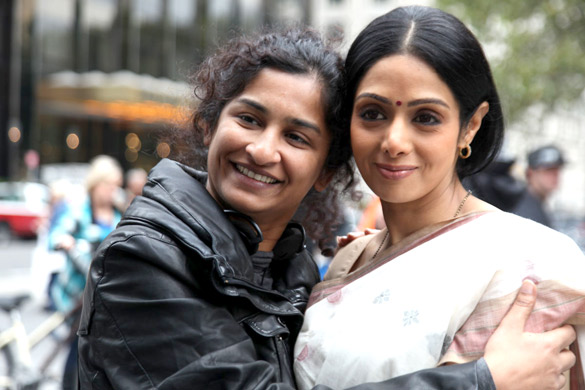Sridevi (1963-2018): In Memoriam Posted by Rachael on Feb 28, 2018 in Hindi Language, Uncategorized
On February 24th, 2018, the Hindi film industry and the citizens of India lost one of their brightest stars and most lovable personas: the actress (अभिनेत्री/abhinetri, fem. noun) Sridevi passed away (गुज़र जाना/guzar jaanaa) in Dubai while visiting for her nephew’s wedding. Once they learned of her passing, people in every corner of the globe began what will be a long process of mourning. She was the first female superstar in a film industry that is, to this day, largely male-dominated. Despite this status quo of India’s film industries, Sridevi was able to carry film after film on her own shoulders, without the aid of a big male star and, in fact, she often overshadowed both her male and female co-stars. An incandescent actress and person, she was highly versatile (बहुमुखी प्रतिभावाला/bahumukhi pratibhaavaalaa or “multi-talented”) and hugely talented, excelling at comedy, drama, tragedy and romance and known for her skillful dancing (नृत्य/nritya, masc. noun). She was, in short, a legend.
Sridevi (or Shree Amma Yanger Ayyapan) was born (पैदा होना/paidaa honaa) in 1963 in Sivakasi, Madras State (modern-day Tamil Nadu) and made her debut in films as a child star. She appeared in her first film, the Tamil language Kandan Karunai, in 1967 when she was just 4 years old. From there, she starred in several other films as a child star in multiple languages (भाषा/bhaashaa, sing, भाषाएँ/bhaashaae, plural, fem. noun). In 1972, she made her first appearance in Bollywood as a child star in the film Rani Mera Naam/रानी मेरा नाम (Rani Is My Name). She is one of the rare actresses who is versatile not only in her portrayal of emotions (भावना/bhaavnaa, fem. noun, follows same pattern as “भाषा/bhaashaa”) and characters (किरदार/kirdaar or चरित्र/charitra, both masc. nouns) but in her ability to act in several different languages (she appeared in Tamil, Kannada, Malayali and Telugu films, in addition to Hindi) and thus achieve pan-Indian appeal. Therefore, at her passing, both North and South India were united in their love and appreciation of this star, which is uncommon indeed.
As an adult, her first starring role in Hindi cinema occurred in Solva Sawan/सोलह सावन (“Sixteen Rainy Seasons/Monsoons,” 1979). Then, in 1983, she gained greater recognition for her talent (प्रतिभा/pratibhaa, fem. noun) with the film Himmatwala/हिम्मतवाला (The Courageous One). Her work in this film carved out a niche for her in Bollywood as a force to be reckoned with, and she was particularly lauded for her performance in the song and dance number “Nainon Mein Sapna/नैनों में सपना” (“A Dream in My Eyes”). Throughout the 80s and 90s, Sridevi starred in a myriad of films that were either commercially successful (सफ़ल/safal) and/or in which she was praised particularly for her acting (अभिनय/abhinay, masc. noun), although the film itself was not commercially viable (असफ़ल/asafal=unsuccessful). One of my favorite films, starring Sridevi as a crime journalist, is the 1987 hit Mr. India in which Sridevi, predictably, steals the thunder of her male co-star (Anil Kapoor) by displaying her killer comedic timing with her memorable imitation of Charlie Chaplin, her infectious humor and enthusiasm, expressive eyes and face and marvelous dancing. Several film reviewers even joked that the film should have been renamed Miss India in honor of her stunning performance. Perhaps her most famous song and dance number in this film, “Hawa Hawai/हवा हवाई” (“Vanished Completely”) was so beloved that the name of the song (गाना/gaanaa, masc. noun) later became one of the actress’s most popular nicknames.
In addition to her acting and dancing skills, Sridevi was a classic beauty (सुंदरी/sundari, fem. noun) with distinctively large eyes and a curvaceous figure that enabled her to be sensuous when required, as she was in the rain song “Kaate Nahin Kat Te,” for which she became known as a “goddess in a blue sari.” Later in her career, Sridevi’s work under the renowned director and producer Yash Chopra in the films Chandni/चांदनी (Moonlight, also the name of the character, 1989) and Lamhe/लम्हे (Moments, 1991). In the former film, Sridevi’s performance won her recognition (मान्यता/maanyataa, fem. noun) not only as a skilled actress but for her rendering of this distinctive character. In Lamhe, Sridevi played both the mother and daughter roles, showcasing her versatility in a double role much as she had done playing twins separated at birth in an earlier film, Chaalbaaz/चालबाज़ (Imposter, 1989), for which she won her first Filmfare award (पुरस्कार/puraskaar, masc. noun) for Best Actress. Although Lamhe was not commercially successful, as it dealt with controversial subject matter, she won her second Filmfare Award for Best Actress for her work in this film.
As was common for many actresses of the time after they married and had children, Sridevi took a break (अवकाश/avkaash, masc. noun) from films only to return to the small screen as the title character in the sitcom “Malini Iyer” (2004-2005). She also appeared on fellow actor Aamir Khan’s social issue talk show “Satyamev Jayate/सत्यमेव जयते” (“The Truth Will Prevail”) in 2012 as a surprise guest (मेहमान/mehmaan) to honor the wish of an interviewee who was sexually abused as a child. Sridevi, along with Aamir Khan, then signed a letter addressed to the government advocating the passage of a law criminalizing the sexual abuse of children. Also in 2012, Sridevi made a memorable return to film with the comedy-drama English Vinglish, my favorite film of hers. In English Vinglish, Sridevi assumes one of her most successful and sympathetic roles as Shashi Godbole, a housewife (घरवाली/gharvaali) who decides to take an English as a Second Language course in New York City while visiting for her niece’s wedding, motivated by her husband and daughter’s condescending attitudes toward her poor English.
Sridevi is incredible in this role as an unappreciated and unfulfilled woman with great, unrecognized talents who remarkably summons the courage (साहस/saahas, masc. noun) to improve (सुधारना/sudhaarnaa) her life and self-esteem by learning English. Viewers can’t help but sympathize with Shashi’s personality and her situation as a timid housewife whose opinions and ideas are often ignored or ridiculed. With this film, Sridevi became one of the few actresses who proved herself capable of staging a successful comeback after a lengthy break from film. This is also a great film to watch for beginning Hindi learners as it is easily understandable. Moreover, it is a fascinating meditation on English dominance (प्रधानता/pradhaantaa, fem. noun) in India and the world at large and the dwindling appreciation and importance of Hindi in a globalized, capitalism-oriented society.
Her final film and 300th role came with the thriller Mom/मोम (Wax, 2017), in which Sridevi plays a mother who is determined to avenge (बदला लेना/badlaa lenaa) her daughter’s rape. At only 54 years old, Sridevi’s death (देहांत/dehaant, masc. noun) was an untimely shock (सदमा/sadmaa, masc. noun) to her immediate family, including husband Boney Kapoor (a film producer) and two daughters, her film family, India as a whole and anyone in the world who has watched her films and loved this unparalleled actress. She will be sorely missed.

Build vocabulary, practice pronunciation, and more with Transparent Language Online. Available anytime, anywhere, on any device.







